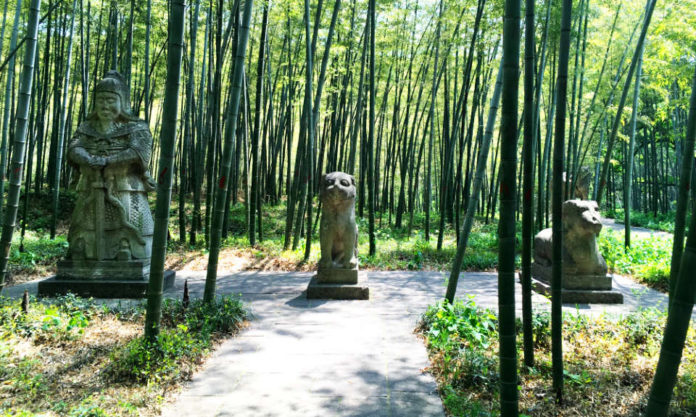Ming Xiaoling, the tomb of the Zhu Yuanzhang, first emperor of the Ming dynasty, ranks among Nanjing’s top attractions. Perhaps lesser known, however, are a smattering of tombs throughout the city that belong to generals and officials who also played a key role in the establishment of the Ming dynasty, with its capital here, in 1368. Although significantly smaller than the emperor’s mausoleum, each tomb has a certain charm and the rather more peaceful, intimate settings make for a worthy visit.
The first ones I found were the tombs of brothers Wu Zhen and Wu Liang, just a stone’s throw from Gangzicun Metro Station, exit 1, on the western slopes of Purple Mountain. Expecting to find some sort of park, New Century Garden (Xinshijie Huayuan) turned out to be a residential complex and as a visitor I had to sign in. It seemed an unlikely location for two 600-year-old tombs, but the guards at the front gate were incredibly friendly and knew exactly where to direct me. There the tombs were, tucked away between housing blocks, nestled among the unruly foliage.
- A Royal Success; The Largest Exhibition of Chinese Art Ever
- When Art History Goes into the Washing Machine
- Five Steps to Fudging with Finesse
Ming generals Wu Zhen and Wu Liang were brothers from Anhui and both influential in Zhu Yuanzhang’s overthrow of the Mongol Yuan dynasty. To be buried on Purple Mountain was a great honour, while the location of their tombs added extra protection to the emperor’s mausoleum on the southern side of the mountain.
As you walk in on your left is a tortoise (or bixi), which would once have had a stone tablet on its back detailing the tomb occupant. The central corridor, known as the spirit way, consists of stone statues in pairs; horses and attendants, rams, lions and officials. The stone animals and figures not only serve to protect the deceased, but each of them carries a symbolic meaning too. Rams for example represent justice, while lions symbolise power and authority.
At the end of the spirit way, in front of where the deceased would have been interred, two officials stand face to face, thickset and grounded, their expression impassive. The abstraction of their facial features, according to art historian Ann Paludan, was deliberate and expressed an ideal virtue. But for what may lack in facial detail is made up in the intricate carving of their attire. Swirling cloud and flower patterns contrast with sharp geometric chainmail, while the shoulder pads of each official are adorned with a beast’s face.
- Warhol’s “Disco Lights” in China
- Making a Mark; The Power of Peppa
- Why is Red Not Always Lucky in China?
Immediately behind the short spirit way is another collection of stone statues in much the same configuration, except one of the officials is almost comically shrouded in palm trees. The tomb platform is simple and anticlimactic, despite doubts as to whether the brothers were in fact buried here.
The stone figures do not differ greatly from those at Ming Xiaoling, but a lack of tourists and sense of secrecy at this site allows for more peaceful contemplation. As Paludan puts it, “They demand full attention. When you take time, however, and look up at one of them, you become slowly aware that the figure appears to be looking back at you, telling you something. The sculptors have succeeded in imbuing the heavy block of stone with a spiritual quality which is still eloquent nearly six hundred years later”.
A short walk southeast of the same metro station takes you to another two tombs, those of Qiu Chen and Chang Yuchun, the latter of which is set against a picturesque bamboo backdrop, while in the north, Li Wenzhong and Xu Da’s tombs are much grander, but currently under renovation and may not be open until later this year.









